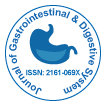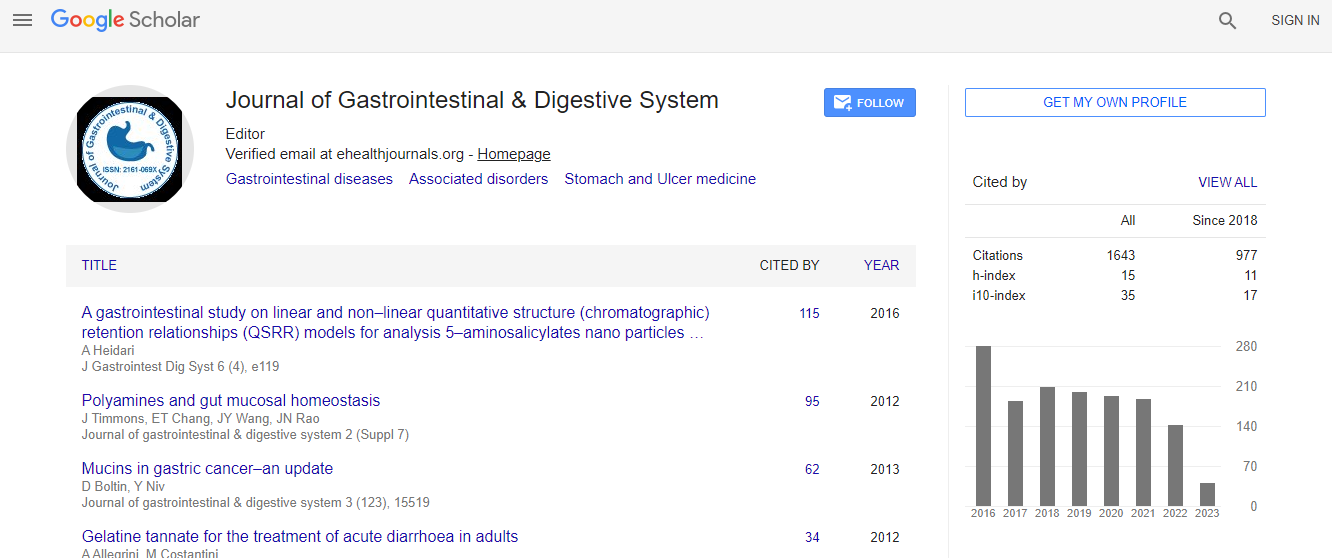Our Group organises 3000+ Global Conferenceseries Events every year across USA, Europe & Asia with support from 1000 more scientific Societies and Publishes 700+ Open Access Journals which contains over 50000 eminent personalities, reputed scientists as editorial board members.
Open Access Journals gaining more Readers and Citations
700 Journals and 15,000,000 Readers Each Journal is getting 25,000+ Readers
Google Scholar citation report
Citations : 2091
Journal of Gastrointestinal & Digestive System received 2091 citations as per Google Scholar report
Journal of Gastrointestinal & Digestive System peer review process verified at publons
Indexed In
- Index Copernicus
- Google Scholar
- Sherpa Romeo
- Open J Gate
- Genamics JournalSeek
- China National Knowledge Infrastructure (CNKI)
- Electronic Journals Library
- RefSeek
- Hamdard University
- EBSCO A-Z
- OCLC- WorldCat
- SWB online catalog
- Virtual Library of Biology (vifabio)
- Publons
- Geneva Foundation for Medical Education and Research
- Euro Pub
- ICMJE
Useful Links
Recommended Journals
Related Subjects
Share This Page
Prevelance of occult HBV in chronic hepatitis C and cryptogenic hepatitis patients
Joint Event on 13th International Conference on Pediatric Gastroenterology Hepatology & Nutrition & 3rd International Conference on Digestive and Metabolic Diseases
Cakal B
Department of Microbiology and Clinical Microbiology, Istanbul University, Turkey
Posters & Accepted Abstracts: J Gastrointest Dig Syst
Abstract
Occult Hepatitis B Virus (HBV) infection (OBI) is considered as the possible phase of the HBV natural history but the molecular mechanisms and clinical impact and epidemiological aspect of OBİ remains unclear. We investigated the prevalence of OBI and its clinical impact among patients with Hepatitis C virus (HCV) infection and with cryptogenic hepatitis. This study protocol was approved by the ethics committee of İstanbul University İstanbul School of Medicine (No: 2015/1519). This prospective cohort study included a total of 60 HBsAg-negative patients (27 patients with chronic HCV and 33 patients with cryptogenic hepatitis) were enrolled in the Department of Gastroenterology, Istanbul Faculty of Medicine. Liver tissue samples had been obtained by percutaneous needle liver biopsy and immediately frozen and stored at -80°C. Total nucleic acids were extracted from frozen liver biopsies using QIAamp DNA Mini Kit (Qiagen) according to the manufacturer’s instructions. OBI was defined as HBV DNA positivity in 2 or more different viral genomic regions by nested polymerase chain reaction PCR using 4 sets of primers in preS-S (S), precore-core (C), Pol, and X viral regions of the HBV genome. Plasmid HBV DNA 4.1 kb and liver biopsy samples obtained from patients with chronic HBV infection (positive control) were used. Statistical analyses were evaluated using Mann-Whitney U test, Chi-square test and Kruskal Wallis tests. The baseline characteristics of patients are presented in figure 1. The prevalence of OBI was 25.9% (7/26) with 27.3% (9/33), 26.7% (16/60) in patients anti-HCV (+), cryptogenic hepatitis, and totaly respectively. There wasn’t any significant differences for prevelance of OBİ between patients with chronic HCV infection and cryptogenic hepatitis (P=0.907). Patients with anti-HCV (+), OBİ (+) were older compared with patients anti-HCV (+), OBİ (-), (P: 0.033). As it is expected that cryptogenic hepatitis patients had higher serum alkaline phosphatase and gamma-glutamyltransferase level (P<0.05). Clinical signifance and role of OBI in patients with chronic HCV infection is controversial. Accordingly, first results of the study with respect to prevelance of OBİ is correlated with endemicity of Hepatitis B infection; moreover OBİ can be associated with liver injury rather than chronic HCV infection. Therefore, it appears that host factors rather than viral factors are more responsible for OBI.Biography
E-mail: bulentcakal@yahoo.com

 Spanish
Spanish  Chinese
Chinese  Russian
Russian  German
German  French
French  Japanese
Japanese  Portuguese
Portuguese  Hindi
Hindi 
